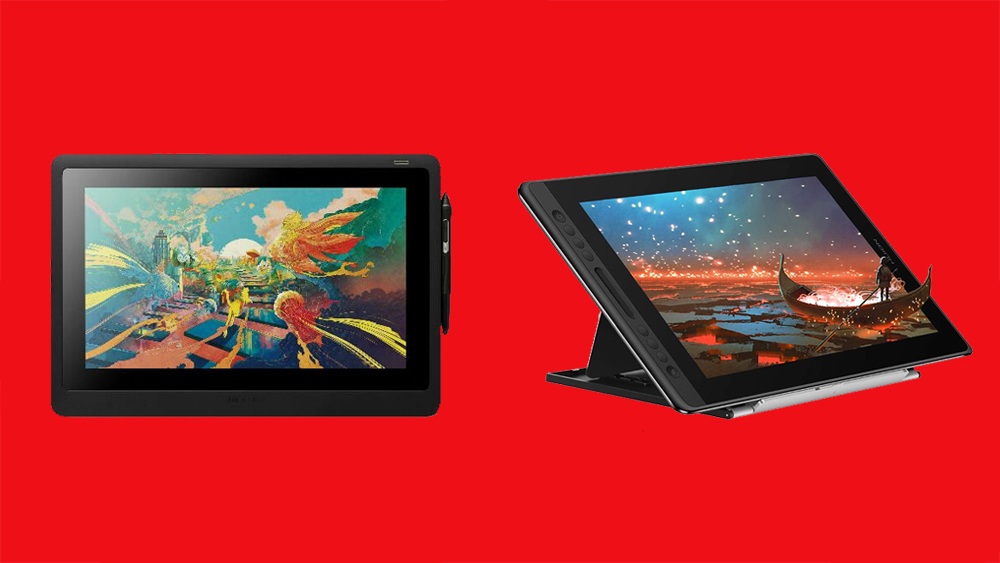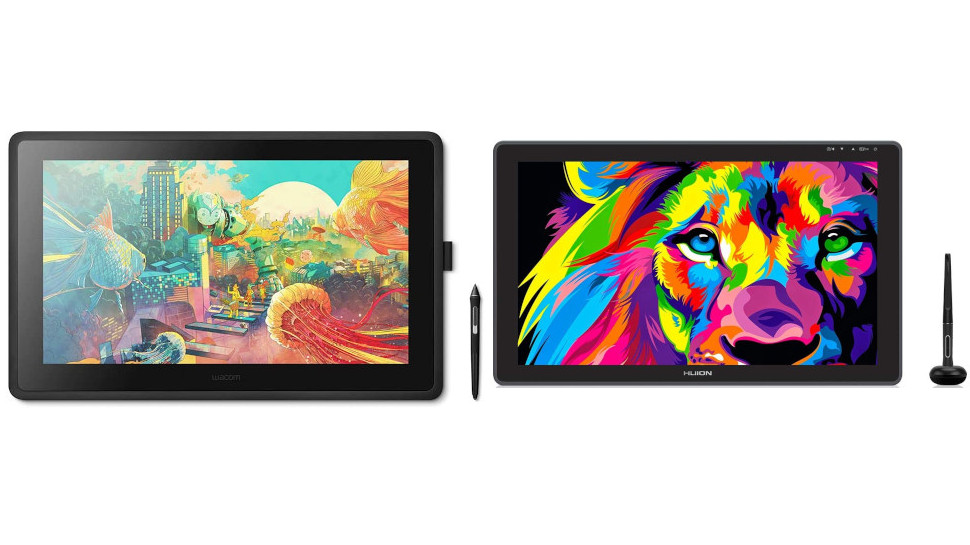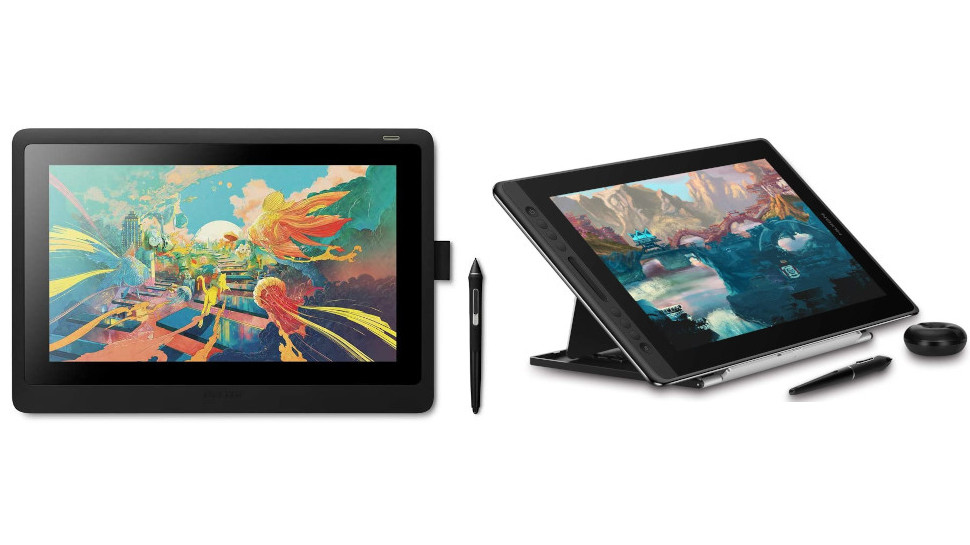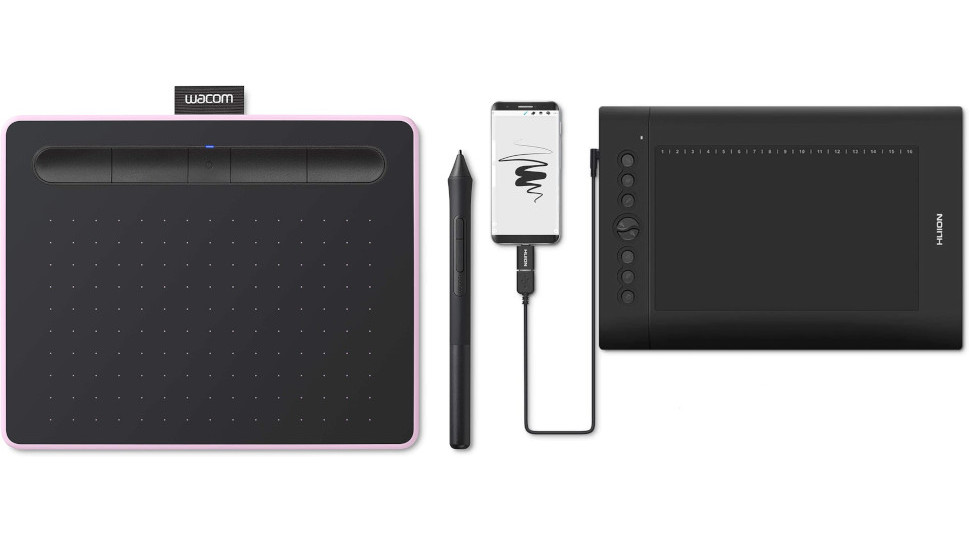Wacom vs Huion: Which is right for you?
Trying to decide on Wacom vs Huion? Here's what you need to know about the pros and cons of each brand.

Weighing up the pros and cons of Wacom vs Huion? You’re not alone. Where Wacom was once the only name in drawing tablets, competitors like Huion have carved out a niche by providing compelling, affordable alternatives to the market leader.
What’s more, it’s no longer just a simple matter of one brand being high-quality and the other being cheap. Huion has improved its more serious, professional tablets to the point where they seriously compete with Wacom’s flagship models. Wacom, meanwhile, has filled out the more affordable end of its range, with budget tablets to tempt those who don’t have huge amounts to spend.
Huion has made a big splash in the tablet world with its Kamvas range, comprising tablets that offer a notable step up in quality from other Huion products. These professional-grade tablets are equipped to challenge Wacom’s comparable offerings, and can be picked up for a cheaper price.
In this guide we place key Wacom and Huion tablets side by side to compare and contrast their features, helping you decide which brand is right for you. We’ll also take a look at the lower end of the scale, and see how something like the Huion H610 Pro V2 compares to the more affordable Wacom Intuos Small. Huion is something of a market leader in terms of budget tablets, so there's plenty to cover.
Keen on one or the other? We've compiled the very best cheap Wacom tablet deals, as well as the best deals we can find on Huion drawing tablets, and we've also put together our ultimate list of the best drawing tablets out there. And if you want to explore some more options, we've also got the best Wacom alternatives out there.
Wacom vs Huion: Design

Huion and Wacom both take quite a minimalist approach with the design of their tablets. If we compare the Huion Kamvas 22 Plus and the Wacom Cintiq 22, we’ll see that both are mostly screen, lacking the rows of function buttons you’ll see on a tablet by XP-Pen, for instance. If you want button control, you can pick up a Wacom Expresskey Remote for the Cintiq 22, which gives you 17 programmable buttons and a touch ring. The Kamvas doesn’t have a comparable accessory, though if you have an Android device, you can hook this up to control it.
Both tablets also come with an adjustable stand that allows you to set it to your preferred height. The Wacom stand is a little more flexible, offering angle adjustment from 16° to 82°, but the Huion stand provides angle adjustment of 20° to 80°, so there isn’t a whole lot in it.
Get the Creative Bloq Newsletter
Daily design news, reviews, how-tos and more, as picked by the editors.
In terms of weight there is some significant difference – the Huion Kamvas 22 Plus weighs 3.9kg including stand, while the Wacom Cintiq 22 weighs a considerably more hefty 5.9kg with its stand! While these aren’t exactly travel tablets, if you are going to be regularly carrying it from place to place, that 2kg weight difference is something to consider.
Wacom vs Huion: Display

Let’s talk about displays – and it’s only the higher-end tablets we need to worry about here. One of the most talked-about features of the Huion Kamvas tablets on launch was their hugely impressive colour reproduction. The Huion Kamvas 22 Plus offers a hugely impressive 140% sRGB colour gamut. This is down to Huion’s new Quantum Dots Technology, which also allows the tablet to boast a hugely impressive 1:1200 contrast ratio. It’s the same technology you’d find in cutting-edge Samsung OLED monitors, and provided you’re willing to do a bit of colour calibration on setup, it’s absolutely class-leading.
This is also the case down the ticket with the Kamvas range. The Huion Kamvas Pro 16 has 120% sRGB colour coverage, which outstrips the Wacom Cintiq 16’s 96% sRGB colour coverage. Though once again, it’s on you to do a little calibration to make the most of this – Wacom Cintiq tablets are calibrated out of the box, and will be much more plug-and-play.
Both Wacom and Huion make their tablets with matte, anti-glare screens that can be used easily in bright conditions. Resolution-wise, they are the same across the board, with the Kamvas 22 Plus, Kamvas 16, Cintiq 22 and Cintiq 16 all boasting Full HD (1920 x 1080) displays.
Wacom vs Huion: Features
As with colour calibration, Wacom tablets are a bit more “plug-and-play” in terms of setup, with software drivers that make it easy to hook the tablet up to a computer and get it working just how you want it to. However, Wacom lacks the Android connectivity that Huion offers on its Kamvas tablets, so if you use Android devices, this is worth bearing in mind.
In terms of styluses, the Wacom Pro Pen 2 is still probably the best on the market – a position it has held for quite some time. Huion has done a good job playing catch-up with its stylus, the Huion PW517, and on paper the two pens are very similar. Both boast 8,192 levels of pressure sensitivity and ±60°. However, and with the caveat that this is subjective, for our money the Wacom stylus still just feels better, with a smoother action and more comfortable weight in the hand.
Wacom vs Huion: Performance
With tablets from both brands, drawing performance is very good across the board. Wacom has got the texture of its tablets down to an exact science, and they feel fantastic to draw on – neither too smooth nor too rough. Huion’s tablets don’t quite have that pitch-perfect feel but they are still very good. Both Wacom and Huion have also done a great job of minimising parallax (distance between the tip of your stylus and the line on the screen) – you’ll only really notice it if you actively go looking for it.
Wacom vs Huion: Price
While Wacom has done a decent job of filling out its budget offering, Huion rules the roost when it comes to cheap drawing tablets. For a two-digit price, you can get hold of an excellent drawing tablet like the Huion H610 Pro V2, a responsive drawing tablet with loads of customisable keys, decent pressure sensitivity and more. And if that doesn’t float your boat, there’s the Huion H640P, the Huion Inspiroy Q11K Wireless, the Huion 1060 Plus… the list goes on, and they all cost less than £99!
Wacom doesn’t have anywhere near this kind of low-budget range, and it’s a pretty well established fact that you do pay a premium for the Wacom brand. Many artists would argue that they are completely worth it, but the fact remains that if price is a major concern, you’ll have more options if you go with Huion.
Wacom vs Huion: Our verdict

It’s tough to argue against Wacom, as the firm makes premium drawing tablets that are excellent across the board. If you are looking for a professional or serious amateur tablet for your digital art, getting a Wacom Cintiq, or really any Wacom, is a fantastic idea.
However, we do want to say a word for Huion, who have crafted ranges of tablets that are seriously competitive on price. The newer Kamvas tablets especially actually outstrip a lot of their Wacom counterparts in terms of on-paper specs, and deciding which is better is more about personal preference and how they feel to use. Huion’s high-end Kamvas tablets like Kamvas 22 Plus offer class-leading colour reproduction and amazing responsiveness.
If you’re a beginner looking for your first drawing tablet, and perhaps aren’t sure if a tablet is right for you, then we highly encourage checking out the fantastic Huion range of budget tablets. You can get a great Huion model for a fantastic price – in this specific arena, Wacom doesn’t compete.
Related articles:

Thank you for reading 5 articles this month* Join now for unlimited access
Enjoy your first month for just £1 / $1 / €1
*Read 5 free articles per month without a subscription

Join now for unlimited access
Try first month for just £1 / $1 / €1

Jon is a freelance writer and journalist who covers photography, art, technology, and the intersection of all three. When he's not scouting out news on the latest gadgets, he likes to play around with film cameras that were manufactured before he was born. To that end, he never goes anywhere without his Olympus XA2, loaded with a fresh roll of Kodak (Gold 200 is the best, since you asked). Jon is a regular contributor to Creative Bloq, and has also written for in Digital Camera World, Black + White Photography Magazine, Photomonitor, Outdoor Photography, Shortlist and probably a few others he's forgetting.
